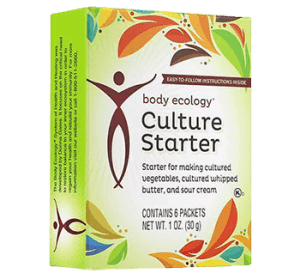Sauerkraut And Vitamin C
COVID protection? Sauerkraut is a superior source of vitamin C
Most of us associate vitamin C with citrus, like orange and lime. After all, the term "limey" comes from a point in history when sailors would use lime and lime juice to prevent scurvy.

Impressive: Sauerkraut made with red cabbage has close to 700 mg of vitamin C per cup. Use our Culture Starter to make your own batch.
Levels of antioxidants and vitamin C in sauerkraut range from 57 to 695 mg.
Scurvy is a disease caused by extreme vitamin C deficiency when the body loses the ability to synthesize collagen. If left untreated, scurvy is fatal.
Jonathan Lamb is a professor at Vanderbilt University and the author of the book Scurvy: The Disease of Discovery.1 Professor Lamb explains that scurvy affected nearly every voyage during the 16th to the mid-19th century when many Europeans set sail to explore the world. Scurvy killed thousands, causing their teeth to fall out and their skin to develop black sores.2
Professor Lamb also recounts the travels of Captain James Cook, who was given 7,860 pounds of sauerkraut to take with him on his journey. After over two years at sea, Captain Cook reported that no one died of scurvy.3
What's the connection?
What is vitamin C, and why does your body need it?
Foods rich in vitamin C prevent scurvy because vitamin C (or ascorbic acid) is needed to make collagen, a protein that is essential to maintain connective tissue in your body. Vitamin C is also an antioxidant — it helps protect your body against stress and free radical damage.
Researchers have found high levels of vitamin C inside immune cells, which is the reason many people take vitamin C during an infection.4 This is also why you may have seen more headlines about vitamin C in the pandemic. Your body rapidly uses up available vitamin C during infection or stress, suggesting that it plays a critical role in immune system health.5
When it comes to promoting immune health to help resist COVID and support recovery, vitamin C is a critical nutrient.
Vitamin C's positive impact on lung health is well-documented, along with its influence on immunity. So much so that an international consortium, including hundreds of researchers, doctors, and healthcare workers from close to 60 countries, has circulated a petition in favor of using high-dose vitamin C as a low-cost, highly-effective option to treat severe COVID-19.6
The recommended dietary allowance (RDA) tells us how much vitamin C we need to avoid disease. The RDA for adult men is 90 mg a day and 75 mg for adult women. Pregnant mothers should get at least 85 mg through diet, whereas lactating mothers should consume above 120 mg since much of their vitamin C concentrates in breast milk.
Can you solve many, if not most, chronic illnesses by repairing your gut? Find out here.
Sauerkraut: A tasty and tangy way to up your vitamin C intake
Raw cabbage on its own already contains moderate amounts of vitamin C — around 30 mg per cup. When you ferment cabbage into sauerkraut, its vitamin C and antioxidant levels skyrocket.7
According to researchers at Cornell University, levels of antioxidants and vitamin C in sauerkraut range from 57 to 695 mg — with raw, fermented red cabbage having the highest levels of vitamin C, hitting almost 700 mg per cup.7
Besides boasting high levels of vitamin C, sauerkraut also contains other antioxidants that help protect against stress and fight disease. The beneficial probiotics in sauerkraut help inoculate the gut and further fortify the immune system.8 Sauerkraut and other raw, fermented foods made with cabbage, like kimchi, are true superfoods that have a long history of protecting the body when resources were scarce.
When fermenting cabbage at home, we recommend using a starter culture to help ensure that your cultured veggies are filled with safe strains of health-promoting probiotics.
REFERENCES:
- 1. Lamb, Jonathan. Scurvy: The Disease of Discovery. Princeton Univ Press, 2018.
- 2. Lamb, J., & Rigby, N. (2013). The natural history of scurvy: an introductory note. Journal for Maritime Research, 15(1), 3-6.
- 3. Carpenter, K. J. (1988). The history of scurvy and vitamin C. Cambridge University Press. P. 78.
- 4. Carr AC, Maggini S. Vitamin C and Immune Function. Nutrients. 2017;9(11):1211. Published 2017 Nov 3. doi:10.3390/nu9111211.
- 5. Wintergerst, E. S., Maggini, S., & Hornig, D. H. (2006). Immune-enhancing role of vitamin C and zinc and effect on clinical conditions. Annals of Nutrition and Metabolism, 50(2), 85-94.
- 6. Holford, P.; Carr, A.C.; Jovic, T.H.; Ali, S.R.; Whitaker, I.S.; Marik, P.E.; Smith, A.D. Vitamin C—An Adjunctive Therapy for Respiratory Infection, Sepsis and COVID-19. Nutrients 2020, 12, 3760. https://doi.org/10.3390/nu12123760.
- 7. Chun, O. K., Smith, N., Sakagawa, A., & Lee, C. Y. (2004). Antioxidant properties of raw and processed cabbages. International journal of food sciences and nutrition, 55(3), 191-199.
- 8. Mei HC, Liu YW, Chiang YC, et al. Immunomodulatory Activity of Lactococcus lactis A17 from Taiwan Fermented Cabbage in OVA-Sensitized BALB/c Mice. Evid Based Complement Alternat Med. 2013;2013:287803. doi:10.1155/2013/287803.
Source: https://bodyecology.com/articles/sauerkraut-is-a-superior-source-of-vitamin-c/

Posting Komentar